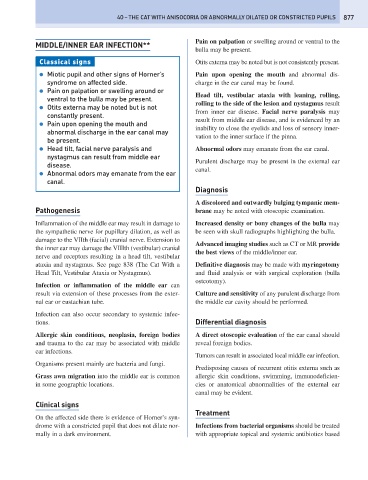Page 885 - Problem-Based Feline Medicine
P. 885
40 – THE CAT WITH ANISOCORIA OR ABNORMALLY DILATED OR CONSTRICTED PUPILS 877
Pain on palpation or swelling around or ventral to the
MIDDLE/INNER EAR INFECTION**
bulla may be present.
Classical signs Otits externa may be noted but is not consistently present.
● Miotic pupil and other signs of Horner’s Pain upon opening the mouth and abnormal dis-
syndrome on affected side. charge in the ear canal may be found.
● Pain on palpation or swelling around or
Head tilt, vestibular ataxia with leaning, rolling,
ventral to the bulla may be present.
rolling to the side of the lesion and nystagmus result
● Otits externa may be noted but is not
from inner ear disease. Facial nerve paralysis may
constantly present.
result from middle ear disease, and is evidenced by an
● Pain upon opening the mouth and
inability to close the eyelids and loss of sensory inner-
abnormal discharge in the ear canal may
vation to the inner surface if the pinna.
be present.
● Head tilt, facial nerve paralysis and Abnormal odors may emanate from the ear canal.
nystagmus can result from middle ear
Purulent discharge may be present in the external ear
disease.
canal.
● Abnormal odors may emanate from the ear
canal.
Diagnosis
A discolored and outwardly bulging tympanic mem-
Pathogenesis brane may be noted with otoscopic examination.
Inflammation of the middle ear may result in damage to Increased density or bony changes of the bulla may
the sympathetic nerve for pupillary dilation, as well as be seen with skull radiographs highlighting the bulla.
damage to the VIIth (facial) cranial nerve. Extension to
Advanced imaging studies such as CT or MR provide
the inner ear may damage the VIIIth (vestibular) cranial
the best views of the middle/inner ear.
nerve and receptors resulting in a head tilt, vestibular
ataxia and nystagmus. See page 838 (The Cat With a Definitive diagnosis may be made with myringotomy
Head Tilt, Vestibular Ataxia or Nystagmus). and fluid analysis or with surgical exploration (bulla
osteotomy).
Infection or inflammation of the middle ear can
result via extension of these processes from the exter- Culture and sensitivity of any purulent discharge from
nal ear or eustachian tube. the middle ear cavity should be performed.
Infection can also occur secondary to systemic infec-
tions. Differential diagnosis
Allergic skin conditions, neoplasia, foreign bodies A direct otoscopic evaluation of the ear canal should
and trauma to the ear may be associated with middle reveal foreign bodies.
ear infections.
Tumors can result in associated local middle ear infection.
Organisms present mainly are bacteria and fungi.
Predisposing causes of recurrent otitis externa such as
Grass awn migration into the middle ear is common allergic skin conditions, swimming, immunodeficien-
in some geographic locations. cies or anatomical abnormalities of the external ear
canal may be evident.
Clinical signs
Treatment
On the affected side there is evidence of Horner’s syn-
drome with a constricted pupil that does not dilate nor- Infections from bacterial organisms should be treated
mally in a dark environment. with appropriate topical and systemic antibiotics based

